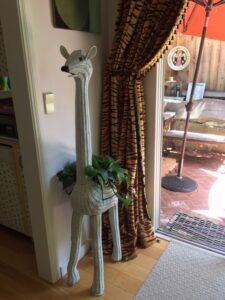 PS owns a whimsical five-foot-tall wicker giraffe plant stand found buried in her late grandmother’s planting shed. When she restored it, she found that somebody painted over the natural buff rattan, white, with a black nose and button eyes. Cute?
PS owns a whimsical five-foot-tall wicker giraffe plant stand found buried in her late grandmother’s planting shed. When she restored it, she found that somebody painted over the natural buff rattan, white, with a black nose and button eyes. Cute?
No, it doesn’t fit with her ultra-modern décor, although she remembers it in her grandmother’s 1970s modern house. She questions what vintage modern really looked like. In her travels through modern furniture shops she hasn’t seen such a thing. So she wonders if it’s a rare “one-off.” Further, is it wicker or rattan?
It’s wicker. Rattan is a material along with other materials for weaving which include bamboo, cane, and synthetic rattan made from engineered resin. Wicker is simply a style of weaving which includes the use of the materials listed above. Wicker goes back centuries. In Egyptian tombs, some as prestigious as King Tutt’s, we find wicker furniture.
King Tutt’s wicker chair lasted thousands of years. He didn’t do destructive things to it: power wash it, leave it outside exposed to UV rays, rain or dew—which leads to mildewed and rot.
This Wicker Giraffe is NOT a “One-Off”
This plant stand in a figure of a thing or animal became popular in the 1970s, a very strange era in terms of style and taste. Animal plant stands as tall as you go along with the unexplainable things we liked in the 1970s: Tang, Jell-O, margarine and white bread, avocado green appliances, Waldorf salad in Tupperware, devilled eggs in custom dishes, platform shoes, chiffon scarves over Bouffant hair, and Richard Nixon.
Wicker HOT in any form in the 1970s
I find wicker plant stands in the shapes of giraffes, owls, elephants, reindeers, turtles, ducks, and rhinoceros. Unexplainable, but after the shock of the 1960s, where nothing was comfortable, a cute, unaggressive shape of an animal seemed comforting. It also made its own statement AGAINST highbrow minimalism in the day. After the stern geometry of the highest style of modern décor in the 1960s, a nice animal was a welcome sight, a grown woman’s form of a cuddly stuffed animal. Definitely not Bauhaus and not International Style at all.
Today I see these animal wicker pieces under the category of Boho-Chic. What does THAT mean? It means a look based on “bohemian” ways of life, based in the 1950s originally, that rebelled against the wartime conservatism. It stood for an artistic, self-expressive individuality. The Chic part comes from the adoption of Hippie culture, ethnic and multicultural. I don’t need to say more about “hippie look.” I remember the Sly and the Family Stone concert in Grant Park in 1970.
Difference Between Boho-Chic and Boho Style
Boho is wilder and reminds us of 100 bangle bracelets, headscarves, and dangle earrings. Boho Chic on the other hand is more urban with a more sophisticated color scheme. Pure Boho reeks of crochet halter tops, fringe, lace, see through fabrics, patchwork, fur, and peasant dresses about to fall off one’s shoulders. Which indicates that the interiors of people supporting Boho are equally artfully unkempt. Not so with Boho Chic.
Boho Chic peaked in 2005 with interiors and clothing featuring folk pieces pared with sleek modern curated pieces. PS’ giraffe is now termed Boho-Chic because it has an ethnic-y feel, and looks modern. The Urban Dictionary defines Boho-Chic as a cheap fashion trend that costs rich young women a lot of money. A trend used by hot females to model crocheted doilies, which costs the seamstress $1 at a flea market, re-made into sexy bra-lettes, selling for $500.
The same thing applies to PS’s giraffe. Once a whimsical addition to her grandmother’s house, and cost extraordinarily little at the time, and was no high culture statement or high art at all. Today we find it on 1st Dibs for $800.
Such a wonderful article, Elizabeth!
Stacey